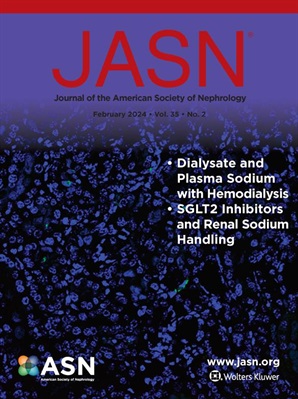Long-Term Outcomes in Nephrotic Syndrome by Kidney Biopsy Diagnosis and Proteinuria.
IF 10.3
1区 医学
Q1 UROLOGY & NEPHROLOGY
引用次数: 0
Abstract
BACKGROUND The UK Registry of Rare Kidney Diseases (RaDaR) Idiopathic Nephrotic Syndrome cohort includes adults and children with genetic nephrotic syndrome, Focal Segmental Glomerulosclerosis (FSGS) and minimal change disease. This study examines long-term patient outcomes as a function of kidney biopsy diagnosis and proteinuria control. METHODS 2467 adults and 1599 children were followed to establish outcomes including eGFR slope and kidney survival by diagnosis, analysed as a function of proteinuria from disease onset for FSGS and minimal change disease. Enrollment began in 2010, with follow-up to September 2023. Index date for the survival analyses was date of disease onset. RESULTS The cohort had median [IQR] follow up of 8.2 [4.3-13.1] years; 30% of patients reached kidney failure or died. 1303 patients had FSGS, 1153 minimal change disease, 105 monogenic nephrotic syndrome. Children showed relatively preserved mean kidney function at disease onset (eGFR>100 ml/min/1.73m2), compared to adults (FSGS 61ml/min/1.73m2; minimal change disease 76ml/min/1.73m2). Kidney survival probability (95% CI) at 10 years varied with diagnosis: Genetic 29% (20-38), FSGS 58% (55-61), minimal change disease 87% (85-89) with mean (SD) rates of eGFR loss -26.5 (34.7), -6.2 (14.3), and -1.9 (10.2) ml/min/1.73m2 per year respectively. FSGS 10-year kidney survival (95% CI) for 6-12 months lowest proteinuria value in complete remission (<0.3g/g), partial remission (0.3-3.5g/g) and no remission (>3.5g/g) was 88% (70-96). 65% (50-76) and 37% (26-48), respectively. Time-averaged proteinuria of <1.5g/g over 6-24 months from disease onset was associated with 90% 10-year kidney survival. For minimal change disease, patients' 10-year kidney survival (95% CI) stratified by 6-12 months lowest proteinuria value was: complete remission 89% (79-94), partial remission 75% (51-89), and no remission 64% (41-81). In FSGS and minimal change disease 10-year eGFR slope was strongly correlated with absolute levels of proteinuria. CONCLUSIONS Kidney outcomes were poor in genetic nephrotic syndrome; in FSGS outcomes were strongly associated with proteinuria level. Minimal change disease patients had better proteinuria control than FSGS and had better outcomes at each proteinuria level.肾活检诊断和蛋白尿对肾病综合征的远期疗效。
英国罕见肾病注册中心(RaDaR)特发性肾病综合征队列包括患有遗传性肾病综合征、局灶节段性肾小球硬化(FSGS)和微小变化疾病的成人和儿童。本研究考察了肾脏活检诊断和蛋白尿控制对患者长期预后的影响。方法对2467名成人和1599名儿童进行随访,以确定诊断时的eGFR斜率和肾脏生存,并分析FSGS和最小变化疾病发病时蛋白尿的功能。登记于2010年开始,一直持续到2023年9月。生存分析的索引日期为疾病发病日期。结果该队列的中位随访时间为8.2[4.3-13.1]年;30%的患者出现肾衰竭或死亡。FSGS 1303例,微小病变1153例,单基因肾病综合征105例。与成人相比,儿童在发病时的平均肾功能相对保存(eGFR bb0 100 ml/min/1.73m2),而成人(FSGS 61ml/min/1.73m2;最小病变76ml/min/1.73m2)。10年肾脏生存率(95% CI)因诊断而异:遗传29% (20-38),FSGS 58%(55-61),最小变化疾病87%(85-89),平均(SD) eGFR损失率分别为-26.5(34.7),-6.2(14.3)和-1.9 (10.2)ml/min/1.73m2 /年。FSGS 6-12个月10年肾脏生存期(95% CI)完全缓解(3.5g/g)时最低蛋白尿值为88%(70-96)。分别为65%(50-76)和37%(26-48)。发病后6-24个月时间平均蛋白尿<1.5g/g与90%的10年肾脏存活率相关。对于最小变化疾病,按6-12个月最低蛋白尿值分层的患者10年肾脏生存(95% CI)为:完全缓解89%(79-94),部分缓解75%(51-89),无缓解64%(41-81)。在FSGS和最小变化疾病中,10年eGFR斜率与蛋白尿绝对水平密切相关。结论遗传性肾病综合征肾功能预后较差;FSGS结果与蛋白尿水平密切相关。最小变化疾病患者的蛋白尿控制优于FSGS患者,并且在每个蛋白尿水平上都有更好的结果。
本文章由计算机程序翻译,如有差异,请以英文原文为准。
求助全文
约1分钟内获得全文
求助全文
来源期刊
CiteScore
22.40
自引率
2.90%
发文量
492
审稿时长
3-8 weeks
期刊介绍:
The Journal of the American Society of Nephrology (JASN) stands as the preeminent kidney journal globally, offering an exceptional synthesis of cutting-edge basic research, clinical epidemiology, meta-analysis, and relevant editorial content. Representing a comprehensive resource, JASN encompasses clinical research, editorials distilling key findings, perspectives, and timely reviews.
Editorials are skillfully crafted to elucidate the essential insights of the parent article, while JASN actively encourages the submission of Letters to the Editor discussing recently published articles. The reviews featured in JASN are consistently erudite and comprehensive, providing thorough coverage of respective fields. Since its inception in July 1990, JASN has been a monthly publication.
JASN publishes original research reports and editorial content across a spectrum of basic and clinical science relevant to the broad discipline of nephrology. Topics covered include renal cell biology, developmental biology of the kidney, genetics of kidney disease, cell and transport physiology, hemodynamics and vascular regulation, mechanisms of blood pressure regulation, renal immunology, kidney pathology, pathophysiology of kidney diseases, nephrolithiasis, clinical nephrology (including dialysis and transplantation), and hypertension. Furthermore, articles addressing healthcare policy and care delivery issues relevant to nephrology are warmly welcomed.

 求助内容:
求助内容: 应助结果提醒方式:
应助结果提醒方式:


